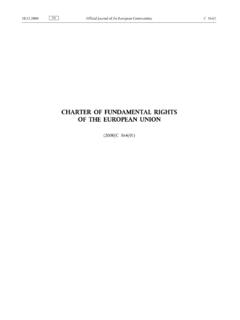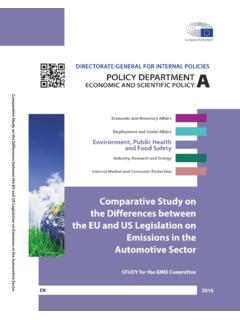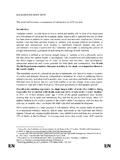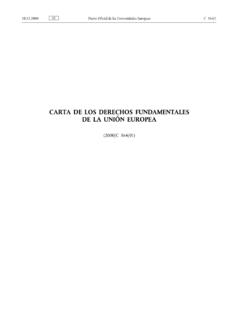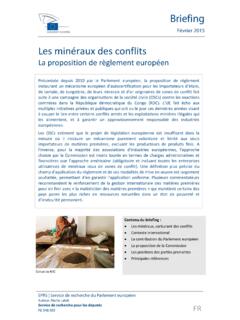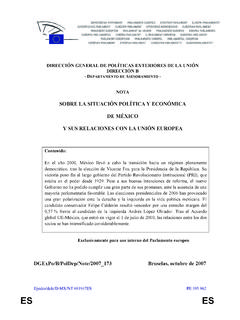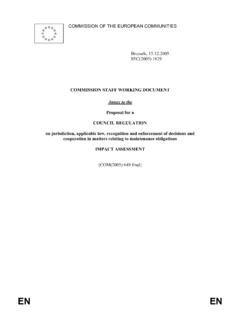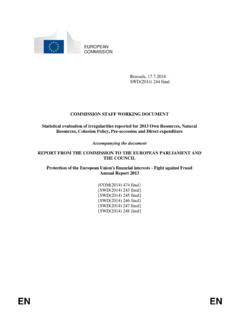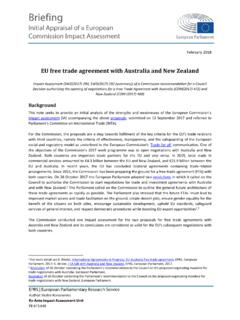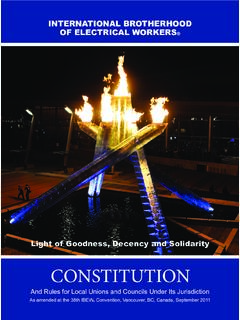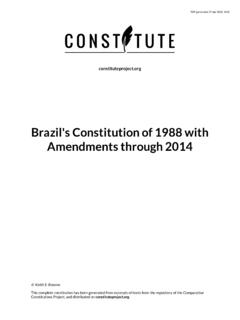Transcription of The European Constitution - European Parliament
1 The European Constitution "The European Parliament endorses the Constitutional Treaty andwholeheartedly supports its ratification"(*): it creates greater clarity as tothe nature and objectives of the union , gives it greater effectiveness and astrengthened role in the world, improves democratic accountability andgives more rights to its citizens. (* European Parliament resolution of 12 January 2005).What is the European Constitution ?In order to work well with 25 Members, the European union needs to be moreeffective, more transparent, more democratic. This is why the 25 have decided toreplace the existing Treaties with a Treaty establishing a Constitution for Europe,commonly known as the European European Constitution defines the values, fundamental objectives and spheres ofaction of the European union and puts in place the machinery whereby its institutionscan determining the union s powers, it also sets the boundaries which it must notoverstep.
2 The union takes action only when it can achieve the desired objectivemore effectively than would be possible at national, regional or local level. This isknown in political jargon as the subsidiarity the Constitution sets the rules: the players then have to play the game!Who drew up the Constitution ?A Convention, made up of holders of elected offices at European and national level,and of representatives of the governments and the European Commission, was heldand produced a draft European Constitution . The 25 adopted this in June 2004 andsigned it in October 2004. In order to enter into force, it will have to be ratified bythe 25 Member States of the European union . This may happen either by vote inparliament or by you need to know about the Constitution 1 The Treaty establishing a Constitution for Europe comprises 448 articles divided into 4 parts :1.
3 The fundamental provisions of the Constitution : definition of the European union , its objectives, itspowers, its institutions and its decision-making The Charter of Fundamental The policies and functioning of the The procedures for adoption and revision of the < The Constitution defines the union as a democratic and open union of equalcitizens and equal states. It proclaims the union s European union is founded first and foremost on values. The preamble and theopening articles of the Constitution set the tone: the union draws inspiration fromthe cultural, religious and humanist inheritance of Europe" and thus defends universalvalues: the rights of the human person, freedom, democracy, equality and the rule oflaw. It aspires to be united in diversity and open to all European States whichrespect its values. It highlights the rights of persons belonging to minorities, pluralism, non-discrimination, tolerance, justice, solidarity and equality between women and , by invoking the will of the citizens and States of Europe to build a commonfuture, the Constitution clearly affirms that the European union is both a union ofcitizens and a union of States (Article 1 of the Constitution ).
4 What is new in the Constitution Fundamental rights for a fundamental law. The economic foundations arestill essential, but the Constitution places the European citizen at is shown by the fact that it incorporates the Charter of FundamentalRights which the Member States have already signed, thus giving it bindingforce. Specifically, citizens may rely on the European Court of Justice toensure that these rights are respected in the carrying out of the union spolicies. So the union will not confine itself to the proclamation of grandprinciples! .. it confirms and clarifies the union s market without borders, freedom of movement and establishment,competition, currency, agricultural policy, reducing the development gaps betweenregions, the ,1 : these European policies are not substantially changed by theEuropean Constitution . It sets out the objectives of the various policies.
5 It does notdefine their content. It also permits the Member States to lead the way in somepolicies without forcing the others to keep up. Finally, it opens the way to a form ofdirect democracy. What is new in the Constitution The economy, social security, the environment. In terms of economic and 1 The annual budget of the European union currently represents some 1% of the union s Gross DomesticProduct. The Constitution provides that the European Parliament and the Council will adopt this budgetjointly. The annual budgets form part of a financial framework set for a period of several years by theCouncil and the policy, the Constitution aims at "a highly competitive social marketeconomy, aiming at full employment and social progress, and a high level ofprotection .. of the environment". The countries of the Euro Group (those countries which have the euro astheir currency) may decide by qualified majority (65% of the population,55% of the Member States in question) on economic policy guidelinesconcerning the euro area.
6 As at present, the European Central Bank will beindependent in its conduct of the union s monetary policy. Enhanced Cooperation. The Constitution will allow one third of the MemberStates to pursue joint action among themselves, subject to approval by theEuropean Parliament and the Council: this is known as enhancedcooperation . The others may join them later. Such cooperation is alreadypossible in the area of Democracy. The Constitution provides for regular dialoguewith citizens, associations representing civil society, and the initiative. A million citizens from several Member States may askthe Commission to propose a law.. it promises freedom, security and justice within the borders of the with the scourges of organised crime and terrorism, which obviously do notstop at borders, the European union is naturally concerned with problems of justiceand policing, which were initially the preserve of the Member States.
7 Hence theconcept of the area of freedom, security and justice , which appeared in theEuropean union in the 1990s. This area will be established gradually: no identitychecks at internal borders, introduction of a common policy on the right of asylum,immigration and external border controls, Europol, mutual recognition of courtjudgments, What is new in the ConstitutionBetter protection for citizens. The Constitution strengthens the union scapacity to protect itself and its citizens. For example, it envisages thecreation of a European Public Prosecutor s Office to combat fraud affectingthe union s finances. The powers of this Office may be extended to coverthe fight against cross-border serious crime (terrorism, the traffic in humanbeings, etc..).As a general rule, the Member States veto over matters of justice andpolicing is abandoned, and the European Parliament is placed on the samefooting as the Council for the adoption of laws.
8 It gives Europe a role in the world, and a common Foreign <Foreign affairs are a sensitive area, close to the hearts of the Member States. At thesame time, the European union can only play a role in world affairs if it is able to letits voice be heard. What is new in the Constitution A Foreign Minister for the European union . The Constitution creates thepost of Foreign Minister of the union , with the job of conducting theEuropean union s fledgling foreign policy a policy which remains largelysubject to the rule of unanimity. The Minister of Foreign Affairs will also beconcerned with trade relations and development defence for Europe. To guarantee peace and security, the Constitutionpermits Member States, if they wish, to take joint action (particularlyoperational missions) and even to undertake structured cooperation amongthemselves. This does not affect the position of the Member States inrelation to new feature: the Constitution expressly provides that the MemberStates must provide one another with aid and assistance in the event ofarmed aggression, terrorist attack or natural disaster.
9 It improves the functioning of an enlarged European union : The EuropeanParliament will adopt most European laws, the European Council will have afull-time presidency, and the post of Minister of Foreign Affairs of the Unionwill be ordinary legislative procedure will look like this: the European Commissionproposes laws, taking account of the European Council s broad policy guidelines. TheEuropean Parliament and the Council of Ministers, on an equal footing, must reachagreement on any changes they judge necessary, and then adopt the toproposals -Adoption of lawsProposals forlegislationBroad policyguidelinesEuropeanCouncilEropeanCo mmissionEuropeanParliamentCouncil ofMinistersEuropeanlaws5/7 What is new in the Constitution The European Parliament becomes a fully-fledged legislature. In a numberof areas, the European Parliament already adopts laws on an equal footingwith the Council.
10 Under the Constitution , this becomes the rule in 9 casesout of 10. There are currently 732 Members of the European Parliament . This numbermay rise to 750, but no further. No Member State may have more than 96 orless than 6 (full-time) President for the European Council. The European Council,comprising the Heads of State or Government and the President of theEuropean Commission, draws up the union s broad policy guidelines. Atpresent its rotating presidency is held every 6 months by a differentcountry. The Constitution provides that it will appoint a President for aperiod of 2 years, renewable new system of voting in the Council of Ministers The Council of Ministers,on which the governments of the Member States are represented, will votemuch less often by unanimity and much more by qualified majority . Atpresent this qualified majority is calculated by means of complicatedweightings.
